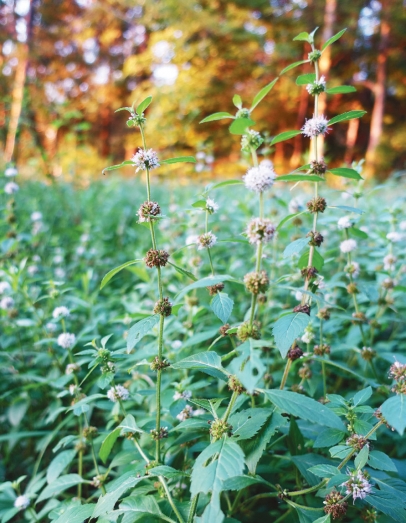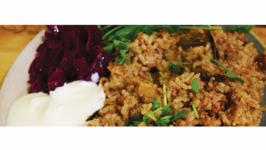Eating Wild: Mint
The Wide World of Mint
It would be difficult to overstate the importance of the mint family of plants to our culinary lives. Sage, rosemary, lavender, thyme, lemon balm, bee balm, oregano, anise hyssop, marjoram, basil, tulsi, horehound, catnip, salvia. While not all of the over 7000 (!) plants in this family – Latin name Lamiaceae – show up on our plates, in our mugs, or in our home remedies, an absolutely bonkers number of them do. And that’s before you even get to the headliner of this giant family of fragrant plants, mint itself.
Much like the larger family, the group of plants we commonly call mint covers a lot of ground, both literally and figuratively. The varieties within the Mentha genus, which contains the familiar mints we know and love are many and have a tendency to escape wherever they are initially planted. This desire to spread to any available ground, along with the ability to tough it out through harsh conditions, makes mint not only a prolific plant in cultivated areas, but throughout wild places as well.
As I’ll readily admit to and have written about before, I am a fairly lazy gardener who far prefers plants that want to do well with little intervention. I’m not looking for a fight, either with a plant itself or with the many environmental factors that can get in the way of a seedling’s success. When I’m planning my growing spaces, I lean toward the unkillables, as long as they aren’t harming the delicate ecosystems around them. A perennial will nearly always win out over an annual, and a cold- and pest-resistant one is even better. So, in my garden, I absolutely delight in all of the peppermint, spearmint, and apple mint that comes back year after year, covering larger swaths of space each season.
But it’s on a stroll through the woods, in a meadow, or along a riverbank that I truly love stumbling on a patch of mint growing wild and free. If you keep an eye out, it is possible to spot mint popping up in a wide variety of locations, from populated areas where the soil has been disturbed, to more pristine and tucked away wild spaces. As with all wild plant harvesting, it is crucial to be able to recognize what you are looking for with complete certainty (and this is especially true while out in the backcountry or on an unfamiliar piece of land). Fortunately, mint is pretty loud-and-clear about its identity, making it a great addition to an enthusiastic forager’s harvest repertoire. With some prior plant knowledge and by taking a few identification steps, wild mint can easily be distinguished from other plants.
If you are familiar with the characteristics of cultivated mint and think you have happened upon some mint growing wild, the easiest place to start in the process of identification is with your nose. That minty aroma we are so familiar with is readily released when a leaf or stem is rubbed between your fingers. You can likely recall mint’s trademark scent with very little effort – cool, fresh, and a bit sharp. It is the scent of toothpaste and gum, tea and ice cream, though the fragrance of the plant is frequently softer than that of commercial products. While a few other plants may somewhat resemble mint, none of those plants will smell minty when the leaves are rubbed, whereas all plants within the Mentha genus will.
The second way to confirm your mint is, indeed, mint, is to roll a stem between your fingers. Mint stems are square, and you will feel those four flat walls as you roll. Once you identify that square stem, take a look at the plant’s leaves. Mint leaves are toothed, ovular or lance-shaped, and grow opposite one another on stems that rise vertically from the ground.
Once you are confident in your discovery of this hardy and useful plant, there are several ways mint can be collected and enjoyed for use. Pull off a few scattered leaves for tea or an herby addition to a recipe, or pinch off the top several inches of the stems just as you would with cultivated mint. If I have found a large quantity of mint (or have more mint in my garden than can be used fresh, which is nearly always the case) I cut the leafy stems and bundle them to hang-dry, pulling the leaves off once they are completely brittle. The dried mint can be stored in airtight jars for use throughout the year. Fresh mint leaves can also be pulled off the cut stems and placed in a dehydrator on low instead of hung to dry. You can begin harvesting mint in the springtime along with some of the earliest cultivated and foraged plants and can continue picking throughout the growing season into the late fall.
My most common use for both fresh and dried mint is in hot or iced tea, with the herb appearing either on its own or as part of a blend. Mint as a tea infusion has been used medicinally throughout history to soothe the stomach and aid with digestion, and is one of my favorite beverages, health benefits aside. I also use mint to make homemade mint ice cream by placing dried or fresh mint in a tied bundle of cheesecloth and submerging it in the dairy base as the mixture heats through.
My go-to savory recipe using mint is a highly adaptable one made with whatever ground meat I have available. Simply brown the meat and simmer in stock with rice, mint, and the tart spice sumac until the rice is cooked. The warming dish, which I serve alongside Greek yogurt, was inspired by some of the Middle Eastern flavors common in my house throughout my childhood, as well as by meals made for me by an Armenian friend in college. In my own kitchen, the flexible recipe has continued to evolve over the years, changing based on my mood and the specific ingredients I have available at any given moment. (Some common add-ins include mushrooms, star anise, and coriander.) Regardless of the changes made, the hearty dish is always a big hit with friends.
So, if you’re searching for a place to start in your quest to learn about wild edible plants, look first to that humble mint patch in your own herb garden. With a bit of careful observation and research you will be ready to seek out this prolific and persistent plant growing wild. And remember – when it comes to the wide world of mint, your nose knows.
*NOTE: Always consult with trusted experts and refer to foraging books and field guides for 100% positive plant identification before consuming any wild plant. As with harvesting any wild plant, and particularly ones like mint that grow in commonly-sprayed areas, take particular care to collect from spaces you know to be chemical-free. Never pick any wild plant from protected spaces. Integrate new foods into your diet in small quantities to gauge any dietary sensitivities, and consult with a doctor if you have any questions or concerns about specific health issues or medication interactions.






